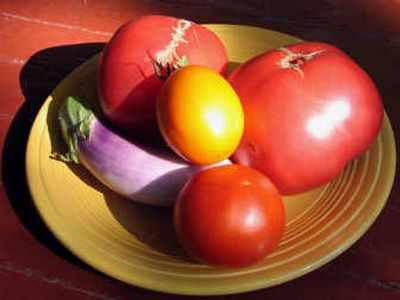Giant tomatoes require huge effort

This has been a tough year for tomatoes.
A cool June reduced early blossoming. Then, highs in the mid to upper 90s zapped a lot of blossoms before they could set, and keeping the plants evenly moist has been a challenge.
So, it was with some satisfaction that I recently picked two nice Brandywine tomatoes weighing in at 14 and 18 ounces respectively.
It felt good, until my editor handed me a copy of the book, “Giant Tomatoes – Giant Yields, Giant Weight,” by Marvin H. Meisner (Annedawn Publishing, 2007).
Did you know that giant tomatoes start at around 2 pounds? The record is a 7.75-pound Delicious tomato grown in 1986.
My two Brandywines each were large enough to fill a big hamburger, but they aren’t “giants.”
It’s going to take a little more dedication to achieve that status.
Growing monster tomatoes is like raising mammoth pumpkins. There is nothing simple about it, and the results are less than pleasing to the eye. They are often gnarled, cracked and misshapen, but they are big, I’ll give them that.
It’s not as if I am jealous, right? But it pays to learn from the best.
Giant tomato growers prune all suckers and some leaves to concentrate growth in one to three leading stems. They fasten them to stakes or cages. They remove early blossoms and wait until late June to allow fruit to set. When the fruiting stems appear, they prune off the smallest two. They constantly look out for “mega-blossoms,” which are elongated blooms that produce the biggest fruits.
Essentially, giant tomato growers sacrifice quantity for size. They also tweak their growing practices. Preparing planting holes in the fall is one trick.
My recommendation is to split the difference. Prune some, but not everything. Pay attention to the details, but don’t worry about every detail.
It may seem obvious, but to get big tomatoes you need a variety known for size. Big Zac, 6 Pound Giant and Phil’s Fantastic are on the list of the all-time largest tomatoes on record. Many heirlooms get big, but most of these are not available from nurseries locally. However, the commonly available Beefsteak, or any of its relatives, will get large.
Another solution is to start your own plants from mail-order seeds under fluorescent lights. Once you’ve mastered the basics, it becomes a seasonal routine, and a way to try new things. You can grow a rainbow of gold, red, pink, purple and striped tomatoes.
No matter what else you do, fertile soil is critical. Tomatoes like a lot of organic matter. Adding bone meal for calcium and phosphorus is essential. I’ve had good results by planting fish scraps in the garden. I prefer organic fertilizers.
The experts will tell you to avoid high nitrogen fertilizers, but that advice is misguided for our region. The Inland Northwest has a higher soil pH, making it difficult for plants to utilize nitrogen. If anything, an acidifying agent such as iron sulfate adds vigor to lackluster plants by making nitrogen more available to roots. Keep in mind that domestic water in Spokane has a pH of about 8.5.
I use those water-filled sleeves that provide early cold protection, allowing a few plants to get going in the garden in April. The world record holder uses them. The sleeves are removed by late May. With them, an early-ripening variety should produce ripe tomatoes around July 4. Larger, slower-maturing varieties will get a significant head start, allowing for better blossom set during the last half of June, and better yields.
When heat arrives, it’s smart to spread a layer of mulch such as grass clippings, straw, peat or compost to keep the soil cool and moist.
When it’s really hot, I give the plants a light mist. Contrary to garden legend, misting does not burn the plants. Just don’t wash off the pollen. Also, it doesn’t hurt to cool the soil with a spray of water. Remember, the key is to keep the soil evenly moist, allowing a mix of air and water to reach the roots. You’ll know if you have watering problems if you start seeing blossom end rot (dry soil) or cracked skins (wet soil).
Like most of us, tomato plants love sun, but not excessive heat, so choosing the right garden site is another key. I would opt for morning to midday sun and late afternoon shade.
As for that question of size, does it matter? Not really. I would prefer yield over size any time.
But size is nice, if for no other reason than it really fills those hamburger buns.